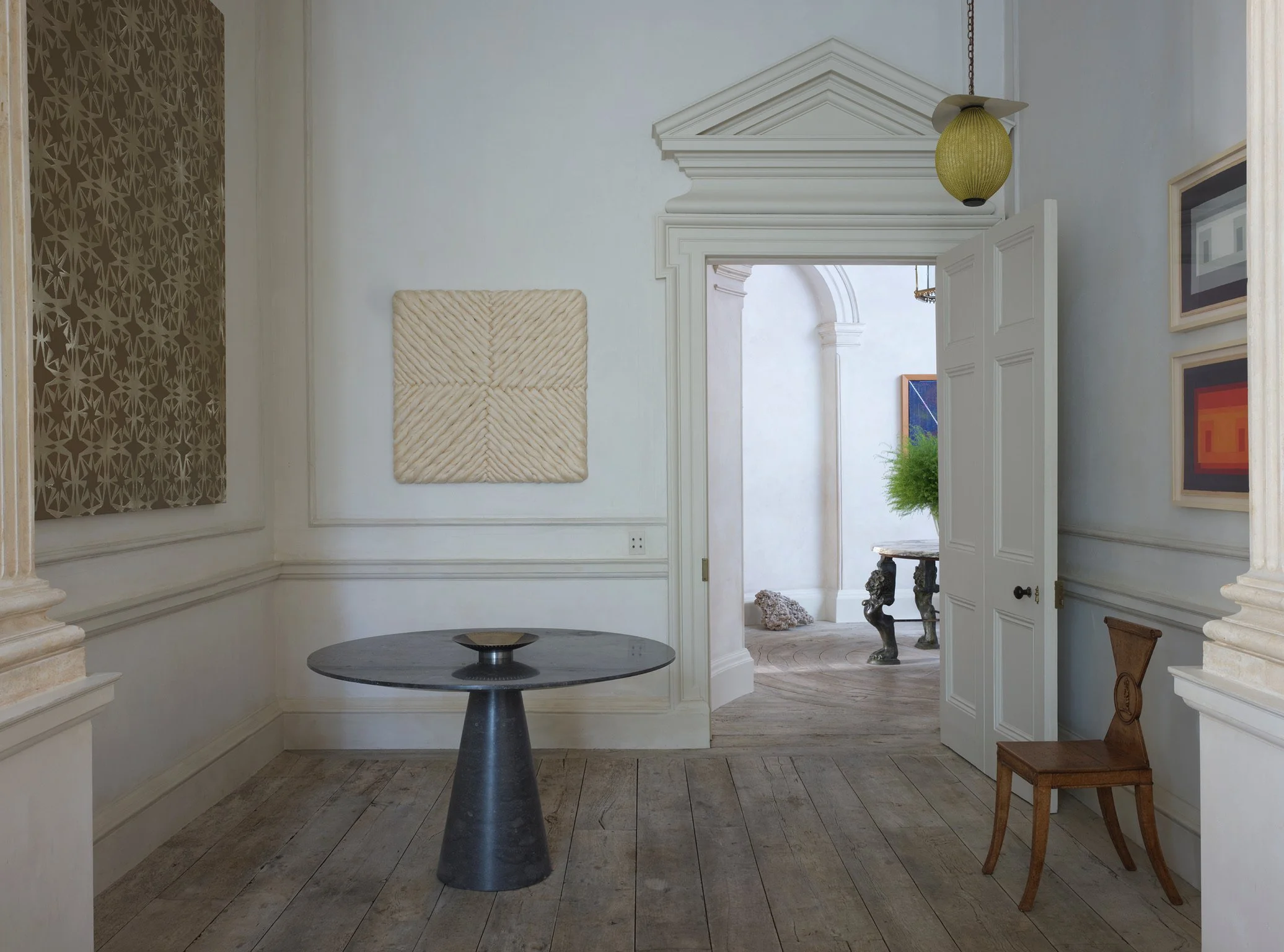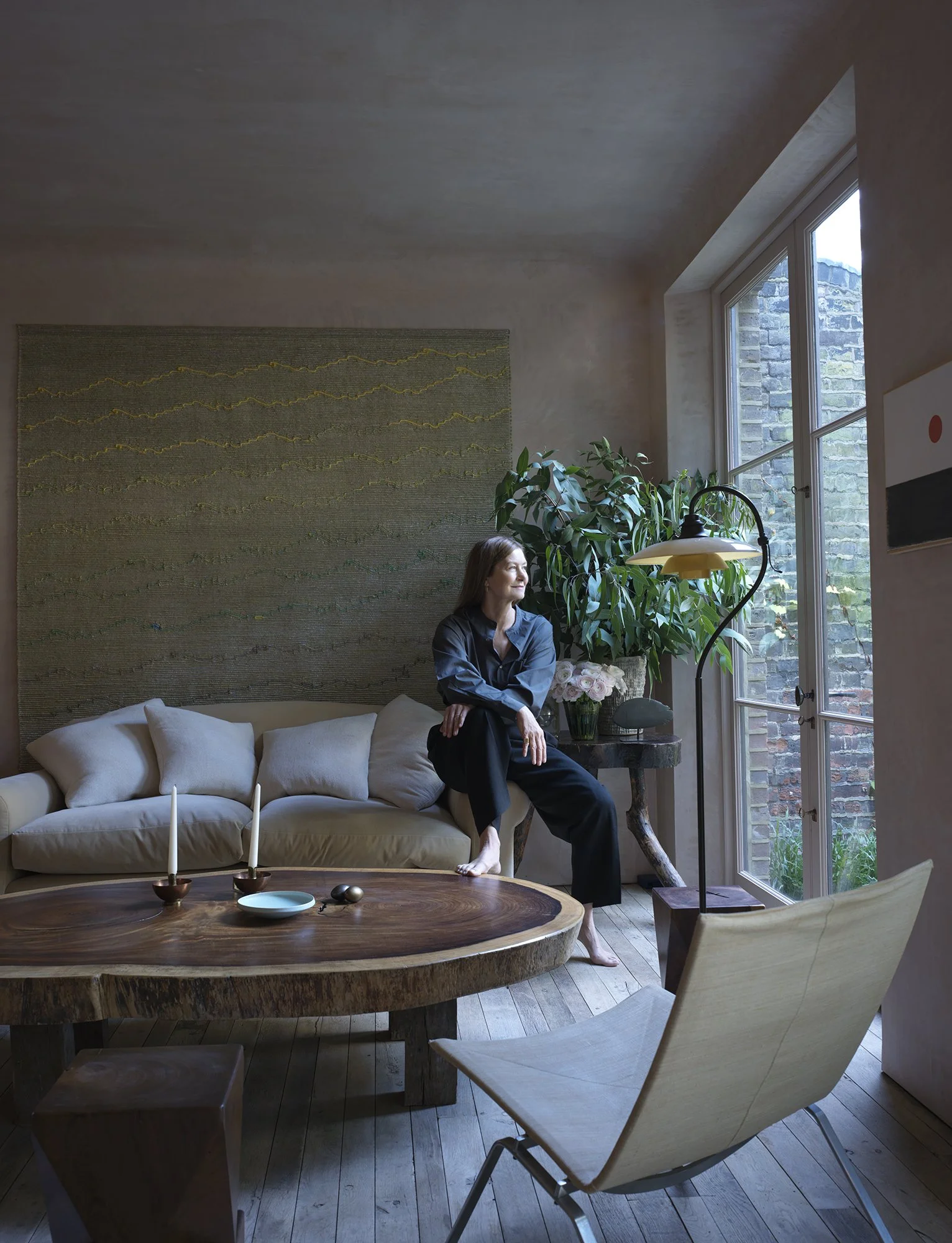The Architect of Lived-In Luxe
Rose Uniacke in her London home. Photography by Simon Upton.
Rose Uniacke
The Architect of Lived-In Luxe
By Bonnie Langedijk
For over two decades, Rose Uniacke has quietly reshaped the language of interior design. Her background in furniture restoration and antique expertise informs a practice that respects a building’s story as much as its form. Today, her eponymous studio handles everything from listed manor houses to private yachts, while her three Pimlico Road shops offer a considered world of antiques, custom furniture, natural textiles, and environmentally conscious paints.
Her aesthetic is often described as minimal, but that’s missing the point. Uniacke’s work is about balance—between architecture and ornament, luxury and restraint, stillness and intimacy. In her hands, interiors become quiet studies in proportion and texture—rooms that don’t just look good, but feel grounded, comfortable, and lived-in.
Alongside her design work, Uniacke continues to source and restore museum-grade antiques for private collectors—many of whom return, project after project. Her Editions line, launched in 2010, began as a response to the pieces she couldn’t find for herself. It has since grown to include furniture, tableware, and a collection of bedlinen defined by natural fibres and a subdued, unmistakably Uniacke palette.
With books published by Rizzoli and a roster of clients that includes David Zwirner, Rosie Huntington-Whiteley and Victoria Beckham, Uniacke has become a quiet authority in international design. Not that she’s particularly interested in trends. For Uniacke, beauty is never about novelty—it’s about how a space makes you feel. And that, as she proves time and again, is the real measure of good design.
Rose Uniacke London Gallery on the Pimlico Road. Photography by Simon Upton.
Rose Uniacke’s London home. Photography by Simon Upton.
When you present at fairs, you reposition antique furniture in a gallery context. While when you work on someone's interior, people are living with those furniture pieces. Do you consider these objects as art?
Rose: That's an interesting and tricky question. Art is purely decorative. Furniture isn't designed to be art; it's designed to be used. There's such a huge distinction between the two. You can hardly compare a painting and a chair. There's so much beauty and love and care in a beautifully made object or a piece of furniture, there's artistic value. I opened the shop in the first place to try to show antique furniture in a contemporary framework. I wanted to show furniture in a spacious way and give it some air. So that you can actually see it, hear it and feel it. I might treat it a little bit like art in that regard. But I'm also somebody who uses furniture. I'm not interested in creating museums of things that you just look at and can't touch.
The context in which you place something can completely change how you view it. When I look at your work, it weaves together the roles of designer, gallerist, and antiques dealer — do you see those as distinct disciplines, or are they led by the same instincts?
Rose: There was no plan. One thing just led to another. I started as a restorer and gilder, buying and repurposing, then became more involved in the design of houses when someone asked me to do their home. I had no intention of ever doing that. I worked for my mother for a bit, I built collections, always trawling French marketplaces. But all the threads come from there. I'll try to find something, or find a piece that needs restoring, and when I can't find what I want, I make it. The first thing I made was a blanket for a client. I couldn't find the right one. Everything was too detailed. So, I made something simple and beautiful of my own design. When I work, I draw on all my knowledge and experience. The business also has a research arm. We want people to buy things worth buying, the right piece for the right person. Some people collect decoratively, others are serious collectors. We have three separate arms to the business, but they are all intertwined. Really, I’m just following my instincts.
“I'm interested in both contemporary STYLE and in traditional interiors. I always think about what it is that I want from a room. What is its purpose? How will it feed you?”
That's also the best place to do business from, because you go in without set rules, or without maybe even knowing all the rules. That allows you to think more freely.
Rose: Absolutely. I like combining different things. I'm interested in both contemporary style and in traditional interiors. I always think about what it is that I want from a room. What is its purpose? How will it feed you? My approach is responsive. All buildings and all projects are different. In terms of furniture, I'm interested in how you sharpen the individuality or the atmosphere of something. Do we want to notice the references of early antiquities in our contemporary ceramics? Do we want to see some of those things in combination? Even if you don't read it, you are taken on some journey. I think interiors that are treated in that way can feel very rich. But I'm not interested in overfilling. Having said that we did a project the other day where the request from the client was a maximalist, full color, full pattern project. It was a very fun project to do.
How do you find the balance with a project like that? You have your own approach, aesthetic but you have to include the client’s style too.
Rose: I'm always going to bring elements of my own taste. At the same time, I’m gathering information and I’m trying to find a way to give my clients what I think they're looking for. There are ways to do a maximalist, colorful, pattern project without it feeling overwhelming. The journey through the house must feel very comfortable. If you're going into a room with a deep color, how do you get there without arriving and feeling shocked? By contrast, if somebody wants an open, more contemporary, more minimal space, how do you do that and give it the atmosphere and the depth at the same time? My interest is in how to balance everything.
We underestimate how much space influences how we feel, how we work, how we connect with others.
Rose: There is absolutely no question about that. It's mood altering.
Is there a certain feeling you hope to evoke for those who inhabit the spaces you create?
Rose: Atmosphere is very important, but it comes later. I don’t think about that to start with. In the first place I'm interested in how a space will function. If we're working on a historic house, we want to honor what it is and maybe we need to restore what it is. I like to honor the history and honor its journey. If we're dealing with a historic house, we would want to get the detailing right. Within that, you have a freedom to shift things a little bit so that there's an edge to the space. If things are too grand, I might try to deconstruct. I don't want an interior sort of flying away in its lightness. It needs to be rooted. Within that framework, there's a lovely opportunity, once you start furnishing, to place objects in unexpected contexts, to make them sing differently. All these things together will create the atmosphere in the house.
Rose Uniacke, Notting Hill House. Photography by Simon Upton.
Rose Uniacke, Notting Hill House. Photography by Simon Upton.
Luxury is an interesting concept because it is so different depending on where you are or what luxury means.
Rose: Luxury has changed over the years. It isn’t any longer about show. It's about something rare, very high quality, not machine made but hand crafted, taking time and immense skill and resulting in something that’s both beautiful and lasting.
Comfort is luxury too, right?
Rose: Comfort and high quality craftmanship is exactly what I think it is.
It must be difficult to do what you do if you're not an intuitive person. You always have to leave room for improvisation. You can't plan everything out.
Rose: I find that's interesting, improvisation, because sometimes things happen, and you have to change course. Somehow things always develop, and problems arise, but it's quite interesting what happens when you must find a solution. And I quite like that challenge. I don't know why that's a happy thing, but it makes you think in a slightly different way.
What are you currently researching, collecting, interested in?
Rose: I'm always looking at all sorts of things. I wear so many different hats. I'm looking at the furniture we're going to take to the winter show in New York, which is in January. I'm also looking at early glass. I'm interested in antiquities and I'm looking at ceramics at the moment as well. Look at this lovely Roman piece. I bought this last week. This is extraordinary. It's a very early piece of glass. It's completely, perfectly intact. Isn't that amazing?
That is beautiful.
Rose: It's unique and rare and beautiful. We are building up a small collection of rare books for a client. I have a piece of furniture that had some shelves, quite a rare bookcase by Jean Prouvé. I've been working on that this morning, sourcing books—the first editions will work beautifully. It's the same as with everything I do. I'm thinking about how to decorate, but also how to honor its function.
Rose Uniacke, Clapham House. Photography by Simon Upton.
Rose Uniacke, Clapham House. Photography by Simon Upton.
Talking about books, I see a book that I own behind you, the Eileen Gray one. I just saw this film about her and the E-1027 house. It talks about Corbusier, and his obsession with the house too, and then he paints over it and it's just the most painful thing.
Rose: I know. It’s awful. It's rather like the story of, do you know Eugenia Errázuriz?
Yes, I do.
Rose: She radically altered the world of interior design in the early 20th century and yet nobody has heard of her. Although Jean-Michel Frank said he owed everything that he did to her. I'm sure even when Gray was working, there must have been, even in those progressive circles, treatment of women that was anything but progressive. It's like women not being able to do what they wanted at the Bauhaus. The Bauhaus was leading the charge and yet the women could only do textile work.
And there are still so many stories left untold while much of how the objects and furniture pieces we live with today are an evolution of their work.
Rose: Yes exactly.
Hopefully we'll not have that when we look back at this generation.
Rose: I think we've moved the goalposts. Things have changed a lot since I was born as well. I'm very glad you've heard of Errázuriz. I think she was amazing. She would have a Picasso on the wall—Picasso was her friend—paired with a very simple chair with a white slip-cover. She released her interiors from the typical trappings of the time removing all fripperies and excess. Simply extraordinary for the period.
This interview has been edited and condensed for clarity.










